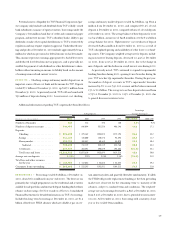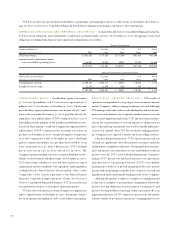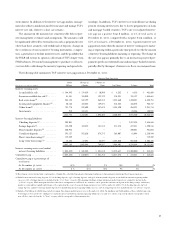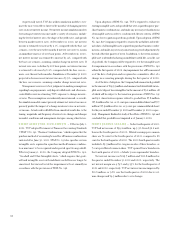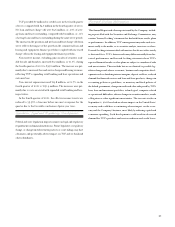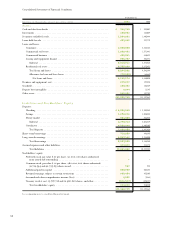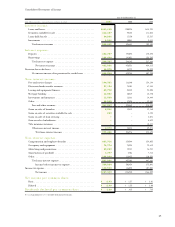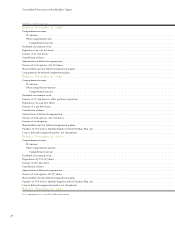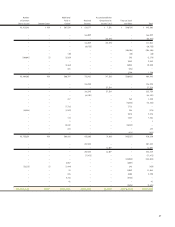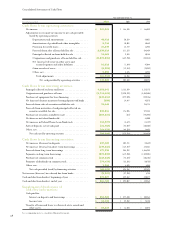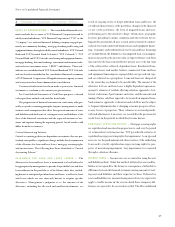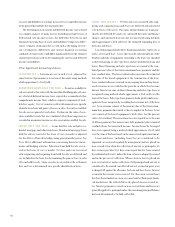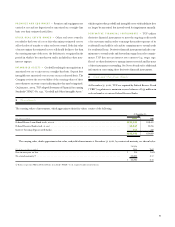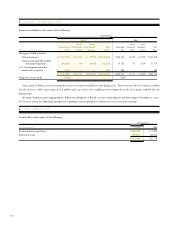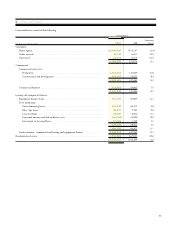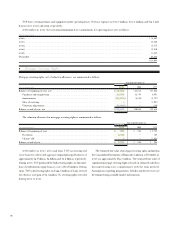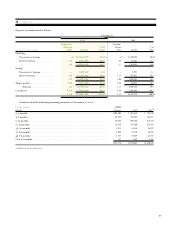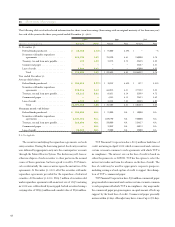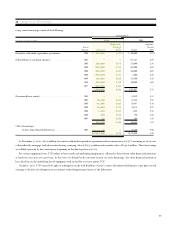TCF Bank 2001 Annual Report Download - page 51
Download and view the complete annual report
Please find page 51 of the 2001 TCF Bank annual report below. You can navigate through the pages in the report by either clicking on the pages listed below, or by using the keyword search tool below to find specific information within the annual report.
49
1Summary of Significant Accounting Policies
BASIS OF PRESENTATION – The consolidated financial state-
ments include the accounts of TCF Financial Corporation and its
wholly owned subsidiaries. TCF Financial Corporation (“TCF” or the
“Company”) is a national financial holding company engaged pri-
marily in community banking, mortgage banking and leasing and
equipment finance through its wholly owned subsidiaries, TCF National
Bank and TCF National Bank Colorado (“TCF Colorado”). TCF
National Bank and TCF Colorado own leasing and equipment finance,
mortgage banking, discount brokerage, investment and insurance sales,
and real estate investment trusts, (“REIT”) subsidiaries. These sub-
sidiaries are consolidated with TCF National Bank and TCF Colorado
and are therefore included in the consolidated financial statements
of TCF Financial Corporation. All significant intercompany accounts
and transactions have been eliminated in consolidation.
Certain reclassifications have been made to prior years’ financial
statements to conform to the current year presentation.
For Consolidated Statements of Cash Flows purposes, cash and
cash equivalents include cash and due from banks.
The preparation of financial statements in conformity with gen-
erally accepted accounting principles requires management to make
estimates and assumptions that affect the reported amounts of assets
and liabilities and disclosure of contingent assets and liabilities at the
date of the financial statements and the reported amounts of rev-
enues and expenses during the reporting period. Actual results could
differ from those estimates.
Critical Accounting Policies
Critical accounting policies are dependent on estimates that are par-
ticularly susceptible to significant change include the determination
of the allowance for loan and lease losses, mortgage servicing rights
and income taxes. The following have been identified as “Critical
Accounting Policies.”
ALLOWANCE FOR LOAN AND LEASE LOSSES – The
allowance for loan and lease losses is maintained at a level believed to
be appropriate by management to provide for probable loan and lease
losses inherent in the portfolio as of the balance sheet date, includ-
ing known or anticipated problem loans and leases, as well as for loans
and leases which are not currently known to require specific
allowances. Management’s judgment as to the amount of the
allowance, including the allocated and unallocated elements, is a
result of ongoing review of larger individual loans and leases, the
overall risk characteristics of the portfolios, changes in the character
or size of the portfolios, the level of impaired loans and non-
performing assets, historical net charge-off amounts, geographic
location, prevailing economic conditions and other relevant factors.
Impaired loans include all non-accrual and restructured commer-
cial real estate and commercial business loans and equipment financ-
ings. Consumer and residential real estate loans and lease financings
are excluded from the definition of an impaired loan. Loan impair-
ment is measured as the present value of expected future cash flows
discounted at the loan’s initial effective interest rate or the fair value
of the collateral for collateral-dependent loans. Residential loans,
consumer loans, and smaller-balance commercial loans and lease
and equipment financings are segregated by loan type and sub-type,
and are evaluated on a group basis. Loans and leases are charged off
to the extent they are deemed to be uncollectible. The amount of the
allowance for loan and lease losses is highly dependent upon man-
agement’s estimates of variables affecting valuation, appraisals of col-
lateral, evaluations of performance and status, and the amounts and
timing of future cash flows expected to be received on impaired loans.
Such estimates, appraisals, evaluations and cash flows may be subject
to frequent adjustments due to changing economic prospects of bor-
rowers, lessees or properties. These estimates are reviewed periodi-
cally and adjustments, if necessary, are recorded in the provision for
credit losses in the periods in which they become known.
MORTGAGE SERVICING RIGHTS – Mortgage servicing rights
are capitalized and amortized in proportion to, and over the period
of, estimated net servicing income. TCF periodically evaluates its
capitalized mortgage servicing rights for impairment. Loan type and
note rate are the predominant risk characteristics of the underlying
loans used to stratify capitalized mortgage servicing rights for pur-
poses of measuring impairment. Any impairment is recognized
through a valuation allowance.
INCOME TAXES – Income taxes are accounted for using the asset
and liability method. Under this method, deferred tax assets and lia-
bilities are recognized for the future tax consequences attributable to
differences between the financial statement carrying amounts of exist-
ing assets and liabilities and their respective tax bases. Deferred tax
assets and liabilities are measured using enacted tax rates expected to
apply to taxable income in the years in which those temporary dif-
ferences are expected to be recovered or settled. The effect on deferred
Notes to Consolidated Financial Statements


